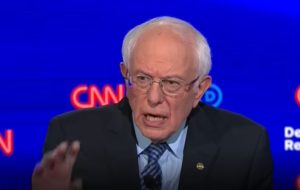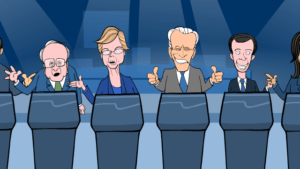We Need to Understand What Happened on Election Night, and Fast
The first thing that occurred to me when the reality of a Trump presidency became apparent was, "How am I going to explain this to my 9-year-old?"
Evan Vucci / AP
The first thing that occurred to me when the reality of a Trump presidency became apparent was, “How am I going to explain this to my 9-year-old?” My son went to bed last night asking me who was going to win. I told him I wasn’t sure, but that it would probably be Hillary Clinton and that I would tell him when he woke the next morning. Earlier at his school that day, he had voted in a mock election in which two sides argued left-wing policies, such as free, universal health care and humane immigration laws, versus right-wing ones. The side of compassion and socio-economic justice won in a landslide—61 to 18 votes—in this hypothetical matchup that was intended to help students understand what democracy means. How was I going to tell him in the morning that the real world of grown-ups had decided to usher in the presidency of Donald Trump?
Only days earlier we had beaten a Trump piñata at a Halloween party, and my kids later gleefully kicked the debris of the torn-up figure, almost as if they were confident the real person would simply disappear the way cardboard figure did when we tossed it in the trash.
But now we are facing a new chapter, one that the largely educated and liberal-leaning voters among us never thought would be possible. Aside from the smug violence we are all likely to face in the coming years, we have lost something great: the ability to offer a better way forward from the economic abyss that has generated Trump’s tenure.
If we do not make sense of what has happened, and do it fast, we have no hope of emerging from this political morass.
First, how could all the polls have been so deeply wrong? On election night, I watched The New York Times’ odometer-shaped predictor start way to the left, the blue section of the wheel giving Clinton a 76 percent chance of winning the presidency. Very quickly, over the course of only an hour or so, that needle began swinging to the redder part on the right, and suddenly I was scraping my jaw off the floor as the prediction skyrocketed to a 94 percent likelihood of Trump’s win. My social media feeds quickly began filling with despairing and confused messages asking what the hell was going on.
Polls leading up to the election were so confident of a Clinton victory that the conjecture was focused not on if she would win, but by how much. The only poll that consistently had a stronger showing for Trump than the rest was the USC Dornsife/Los Angeles Times “Daybreak” poll, which asked different questions than standard polls. That survey gave greater weight to those people who were more deeply confident about their candidate. The L.A. Times explained that “someone who is 100 percent sure of their vote counts more heavily than someone who is only 60 percent sure”; in other words, “a candidate with very enthusiastic supporters who say they are certain to vote may do better than one with wishy-washy backing.” It turns out that this poll was a better predictor of election night’s stunning upset because it actually examined voter enthusiasm, while most others examined the behavior of “likely voters.” Trump managed to draw out people who have often sat out elections. Clinton simply wasn’t able to do the same.
Two months ago, I noticed with alarm that Clinton was not trying very hard to win over economically disaffected voters, which I wrote about in my column entitled “This Election is Hillary Clinton’s to Lose and She’s Screwing It Up.” It bears repeating that “[h]er refusal to even attempt to embrace bold progressive values and her inability to read the simmering nationwide anger over economic and racial injustice are the larger obstacles to her popularity” than any obstacle that her gender might have presented. If her campaign had taken seriously how much better Bernie Sanders would do in a hypothetical matchup against Trump, as reported earlier this year, rather than belittle Sanders as a “doofus,” as John Podesta was revealed to have done in his correspondence, perhaps Clinton might have tried harder to channel Sanders’ populist economic vision.
Instead, she simply offered herself up as the sane alternative to the crazy Trump. And that simply wasn’t enough, as we have now found out to our shock and horror.
My social media feeds are filled with disbelief about the strength and virulence of white supremacy, patriarchy, racism and sexism in the U.S. It is tempting to think that tens of millions of Americans stupidly elected a dangerous new president simply because they hate people of color, immigrants, LGBT people and others. While there is a grain of truth to the existence of such prejudices, the desire to scapegoat others is often a sign of collective weakness and insecurity borne from a sense of loss—in this case the loss of jobs, decent pay, good benefits and more. Desperate masses will tend to pick the leader who offers the most dramatic change and promises to make their wildest dreams come true, no matter how impossible such claims may sound. It has happened in many countries throughout history in a phenomenon that social scientists have studied. Trump’s greatest support came from white voters without a college education.
While it might be tempting to dismiss these voters, it is precisely this dismissal, based on a sense of righteous arrogance among educated liberals, that has angered Trump voters. Educated liberals oversaw the greatest rise in income inequality since the Gilded Age. Educated liberals shipped jobs overseas and championed free trade agreements such as the North Atlantic Free Trade Agreement and the Trans-Pacific Partnership. And all Clinton did was appeal to educated liberals to elect her—an educated liberal just like them. To Trump voters, an exclusive club of elites has taken over the country. Even if the reality is highly different, even if there is great heterogeneity among those who voted for Clinton—in terms of race, gender, age, college education, etc.—it is the appearance of elitism that matters most.
This election was a rejection of the status quo, which was all that Clinton promised. She literally embodied a continuation of the past eight years. Given no other major-party alternative to the status quo, voters chose Trump, because Trump enthusiastically promised an end to the status quo.
This is how I plan to explain to my 9-year-old what happened on election night: Trump won because Clinton simply wasn’t good enough. And now we all need to work harder than ever to stave off the coming wave of right-wing backlash to the morally bankrupt status quo offered during the past eight years of liberal elitism. We have our work cut out for us. We cannot hope that simply not being racist or sexist will save the nation. We need to articulate a bold vision for progressive change that Democrats have resisted for decades, and we need to make it a reality even as the GOP takes control of one branch of government after another. The stakes have never been higher.
Independent journalism is under threat and overshadowed by heavily funded mainstream media.
You can help level the playing field. Become a member.
Your tax-deductible contribution keeps us digging beneath the headlines to give you thought-provoking, investigative reporting and analysis that unearths what's really happening- without compromise.
Give today to support our courageous, independent journalists.






You need to be a supporter to comment.
There are currently no responses to this article.
Be the first to respond.